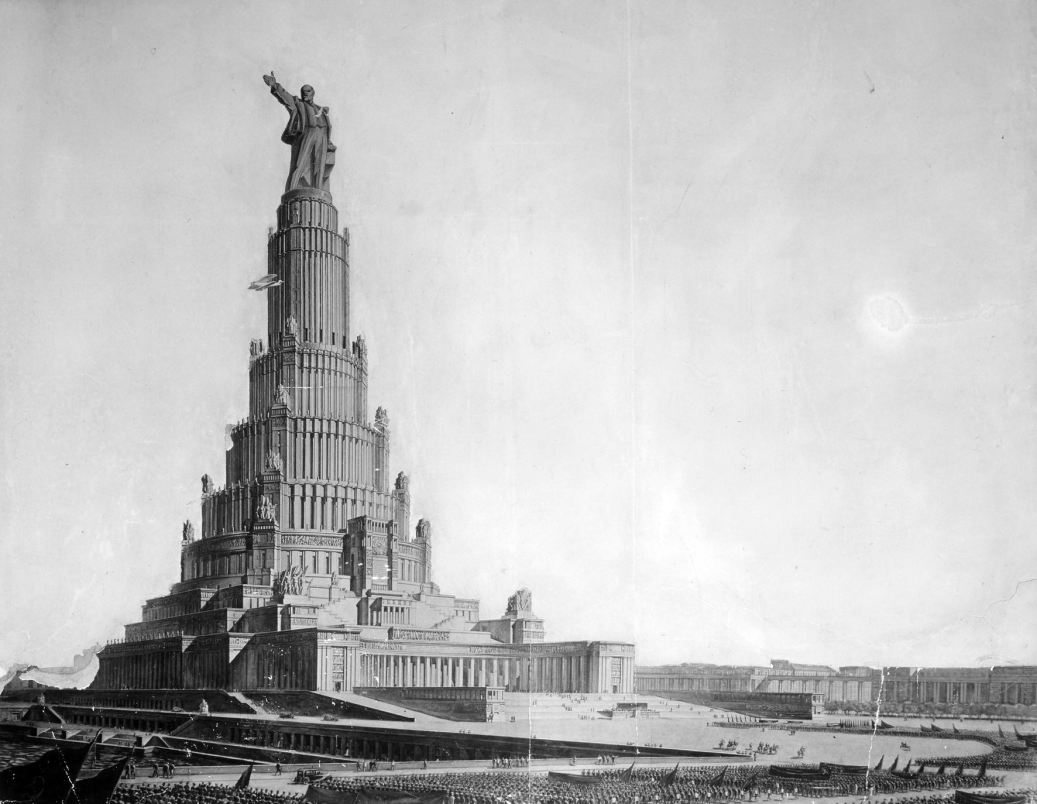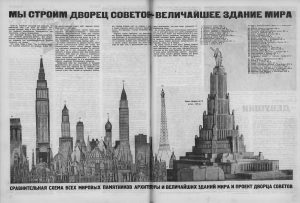Essay / THE PALACE AND POOL
Architecture is not innocent, the basis of realisation is its relationship to power. It is barbaric [1] because by its very nature it is a violent replacement of what already exists, a symbolic overturning of the previous order, an establishment of new conditions, an interruption, a fragmentation, a destruction.
Destruction is the opening up of the new, starting anew, a gesture of tabula rasa – the clearing away of the surplus of opinion. If architecture as “the art of building” automatically carries with it certain values, destruction is, on the contrary, a (momentary) denial of imaginary permanences. The tabula rasa, however, does not exist by itself and can never be achieved. There is no point zero, only a process of elimination. Substitution. [According to Aureli, 2]
The Palace and Pool
“This is a Babel story, but without a Bible; a dissonant fairy tale; no lesson, no allegory, just a grasping.” [3]
The Moskva pool (1958-1995) was the largest swimming pool in Russia, and one of the largest in the world. Today it is no more.
On the site of the former Moskva pool originally stood the Temple of Christ the Saviour. It was the largest Orthodox church in the entire Russian Empire. Built in 1883, it was a contemporary demonstration of the close relationship between church and state. After the October Revolution of 1917, when the tsarist autocratic regime was replaced by the Bolsheviks, the Temple of Christ the Saviour, like many other church buildings, was demolished. The newly established society excluded religion. In addition to church buildings, other monuments to tsarist Russia were demolished, and the city was opened to new communist activity. [4]
The proximity to the Kremlin was strategic, as was the overall very convenient location in the city. Stalin decided to build here a monument (to the Third International), the most representative building of the communist society, the Palace of Soviets. It was to be an administrative centre and a congress hall.
In the 1930s, a competition was announced in which 160 projects (24 foreign) were submitted. The first prize was awarded in February 1932 to Boris Iofan, Ivan Zholtovsky, and the American Hector Hamilton. By the standards of the culture of the time, however, “not a single project could be unequivocally accepted for implementation.” Although the three projects were awarded the top prize, they were still “far from the ideal solution”. There followed a second public competition with recommended projects, then several non-public competitions, a competition with variants by the same authors, and finally Boris Iofan’s project was passed on for further processing. In cooperation with Vladimír Ščuk and Vladimír Gelfrejch, they presented the final project (study) in February 1934, but it was still not the final project. The project still underwent many changes and improvements[5].
“Ostensibly a Stalinist aberration, a cynical pile of meeting rooms for nonexistent collective contained in a pastiche of the American skyscraper, this monstrosity was in fact a political decoy, a savage tactical ploy by Moscow’s architects. … It looked like an insane enlargement of a classical wedding cake; on top, bride and groom morphed to form a huge Lenin, pointing – as always – forward.”[6]
The results of the competition illustrated the polarisation of society. Russia’s pro-Western-oriented constructivists criticized Iofan’s neoclassicism. The Kremlin was behind it. European modernists like Le Corbusier, Gropius, Sert, Giedion,… even wrote to Stalin asking that the project not be carried out. Vladimir Papernyj describes this phenomenon in his study of Stalinist architecture (Culture 2/ Architecture in the Age of Stalin). This was not just a one-off polarisation of society, but a recurring moment of the clash of two cultures. Culture 1 and Culture 2, which are two dialectical poles cyclically alternating throughout Russian history. In his study, he focuses specifically on the 1920s to 1950s, but he also outlines this cyclicality over a wider time span. The 1930s, or the 1932-1934 period when the competition for the Palace of the Soviets took place, is thus also one of the confrontational periods of both cultures, a moment of ideological alternation. [7]
Culture 1 / Culture 2 (According to Papernyj)
Culture 1 and 2 are antagonistic and are rooted in Russian culture separately, out of context of specific ideologies. At the same time, along with their mutual cyclical alternation, the turning point itself, the moment of change, is equally significant. A specific way of equating the incoming culture with the previous one. His study describes, by way of an excursus into history, the Russian “tragic self-destruction and the strange mirth it inspires” [8] demonstrated by the massive demolition, burning, and constant overcoming in grandeur of the incumbent culture by the succeeding one.
The relationship of the two cultures to the past and the future is related to this. Culture 1 looks to the future and firmly and explicitly discards tradition. It sees itself as the beginning of history, which it duly emphasizes, starting “on a green field”, “wanting the future today” [9] . Culture 2 understands the future as eternity, postponing it indefinitely. For Culture 2, the future is even more desirable, but at the same time it becomes unattainable, it lies only in going beyond it (megalomania of projects). It turns, on the contrary, more immediately to the past, it considers itself as the culmination, the end of history. Beginning or end, both extremes are presented with equal intensity and invasiveness.
If the future of Culture 2 is understood as eternity, then forward movement is identified with immobility. It is characterised by an orientation towards the city (the centre), a solidification, an attachment of the population to a place, of which architecture becomes the means. And the latter is to be chained to the ground along with the people. In this spirit, high-rise buildings were built, led by the unrealized Palace of Soviets. What was essential was the weight of the houses, which sat firmly to the ground. Culture 1, on the other hand, was a culture of displacement, of change of state, of dynamism, of impermanence. It is a period of dissolution, of population migration, of orientation towards the periphery, and of spreading population and construction as evenly as possible.
Palace of Soviets as Culture 2
In the conception of Culture 2, the Palace of Soviets was supposed to be an eternal building. “People will be born, generation after generation will live happily, grow a little older, but from dear, childish books, the Palace of Soviets, known to all, will be just as we will all see it in time to come. Centuries will leave no trace on it, we will build it so that it will not grow old, so that it will be eternal.” [10]
Transition 1-2
Five years after the foundations were laid, the war began. Construction stopped, the steel was dismantled for weapons. The Palace of the Soviets, which was never completed and never could have been, is the personification of the vertical nature of Culture 2. The decomposition, the horizontalization of the vertical structure, consisted in turning the foundations of the world’s tallest building into (almost) the world’s most expansive swimming pool. Thus the principle of turning upside down.
Moskva Pool as Culture 1
After the war, from the mid-1950s onwards, also in connection with the replacement of Stalin by Khrushchev, came a new wave of dissolution, a new form of Culture 1. The period of the second futurological wave, (after the first wave of Futurism and Constructivism of the 1910s and 1920s), which most fundamentally confronted precisely the previous revival of Culture 2 (the 1930s-50s). In politics it was a return to Leninist norms, and in architecture to a new interest in the avant-gardes of the 1920s.
“The palace was a strange navel in the heart of the city, an extinguished ideological volcano. … Instead of a solid, the building would become a void: an absence. The foundation, inundated anyway by the persistent leaks, was declared pool. It was big enough for Moscow’s entire population.” [11]
Denial of the Previous Culture
The unrealizable perfection of the Palace of Soviets was replaced by the realization of a public swimming pool.
An absolute borderline situation. The insurmountable hierarchy of the tiered Palace of Soviets was replaced by evenly spaced bathing people. In contrast to the prescriptive regime, the direction of movement was, also thanks to the extraordinary expanse, free and non-directive.
The ideal of Culture 1 was to mix everything together and spread it evenly, “so that the distinctions between town and village, East and West, men and women, rich and poor, between mental and physical labor, work and rest, art and life, would disappear.” [12]
The social concept of the Moskva pool corresponded more to desurbanist ideals than to any other modern urban ideas – from the stamping of boulevards through cities, to functionalist ideas of a tidy city – hierarchical, structured and formally defined concepts. The universalism of desurbanist ideas, among other things, consisted in the search for universally applicable solutions to each new typology. He was guided by the idea of an architectural object of any typology, dimension, form, positionable anywhere.
The Moscow Pool, in its location, seemingly corresponds to placing anything anywhere. An enormous public swimming pool non-hierarchically and loosely situated next to the Kremlin. But the Moskva Pool was not explicitly placed on a representative plot of land, it emerged from the situation. It is turning it inside out. Ideologically and physically, it resulted from the ideological struggle of two alternating cultures. Today the site is occupied by Putin’s newly built replica of the original Christ the Saviour Temple.
Inundating
The Moskva Pool is more of a monument (a watering hole of a previous monument) than a standardized public swimming pool. It is not an institutionalized ruin, an untouchable, rigid, eternally unchanging monument. It is a colossal destruction and a literal watering down. It is not a preserved thing passed on to the next generation, but an always reusable situation, a place.
A (monumental) place of direction and retreat, of alternation and reinvention. A place that is the stable carrier of an unmistakable continuity precisely in the dynamism of the changes it undergoes. An architecturally ephemeral place of ideological condensation. A place where contradictory events – interruption and continuity – meet. Destruction speaks to the transmission of collective experience in a fragmented way.
In this case, the inundating is a metaphor for the materialization of the relations of successive things. Not erasure. The pool represents the megalomaniacal ambition of the Palace of the Soviets by replicating its footprint.
Destruction frees up space; it is not interested in what came before and what will come after. [13] It is a process of sober and reductive insight into the situation. The ideological liberation of the architectural form lies precisely in its clarity as well.
Information and emancipation are contained not in static particulars, but in the moment of alternation, the point of continuity, the point of rupture. A relation and a process.

The original Church of Christ the Saviour. 1883 – 1931. Source: That one time when the Soviet union almost built the tallest skyscraper in the world and Le Corbusier almost helped.

Project of the Palace of the Soviets. Source: Monumentalismo vs. Modernidad?

The Palace of the Soviets as the tallest building, Illustration from Modern Mechanics,1939. Source: That one time when the Soviet union almost built the tallest skyscraper in the world and Le Corbusier almost helped.

Moskva Pool 1958-1995. Source: Christ the Saviour cathedral.